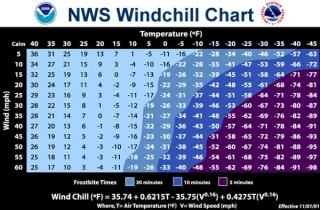Tips for staying warm on cold rides
The temps are falling but we all want to keep hauling! Here are some tips to stay dry and warm during the cold winter months.
Windchill
Wind, rain, snow and altitude changes affect your temperature drastically. Windchill worsens as the temperature drops. For example, riding 20 mph into a 10 mph breeze makes you feel 12 degrees colder at 40 degrees and 19 degrees colder at 20 degrees (see chart above). Be sure to wear several moisture wicking layers so that you can add or remove layers as needed. You'll need fewer layers on climbs and when blessed with tailwinds and more layers for descents and headwinds.
Necks and Noggins
We lose 30 – 50% of our body heat via our head. There is a lot of blood circulation flowing around and through the head and scalp. If we can keep our head warm the body will have a better chance at retaining its’ heat. The neck area, like our heads, is not well insulated and can be another site of heat loss. We need to keep it under wraps as well.
SOLUTIONS: Skullcap, balaclava, turtleneck base layer, high-neck vest.
Core
Layer, layer, layer…..that is the golden rule. If the core isn’t warm then it is highly doubtful that you will be able to keep your extremities warm. It is important to use materials with good wicking properties as a base layer. This layer will wick sweat away from the skin, preventing the rider from getting chilled. Next, you’ll need an insulating mid layer followed by a weatherproof outer layer.
SOLUTIONS: wool or synthetic base, long sleeve jersey, wind stopper vest or jacket with vents.
Hands and Feet
Riding with cold hands and feet is just plain miserable. These two contact points are important for bike control and power to the pedals. By keeping your head and core warm, your hands and feet stand a better chance of staying at a happy temperature.
SOLUTIONS: full-fingered gloves, hand warmer packets between top of hand and glove, wicking socks, wool socks, toes covers, booties, foot warmer packets between shoe and shoe cover.
Knees
When the knees are warm, the synovial fluid around the joint flows more smoothly, the muscles relax more between contractions, and the surrounding cartilage is less likely to suffer micro-tears. The knees have a lot of work to do on our behalf while riding, so always cover them below 60 degrees.
SOLUTIONS: knee warmers, leg warmers, tights.

